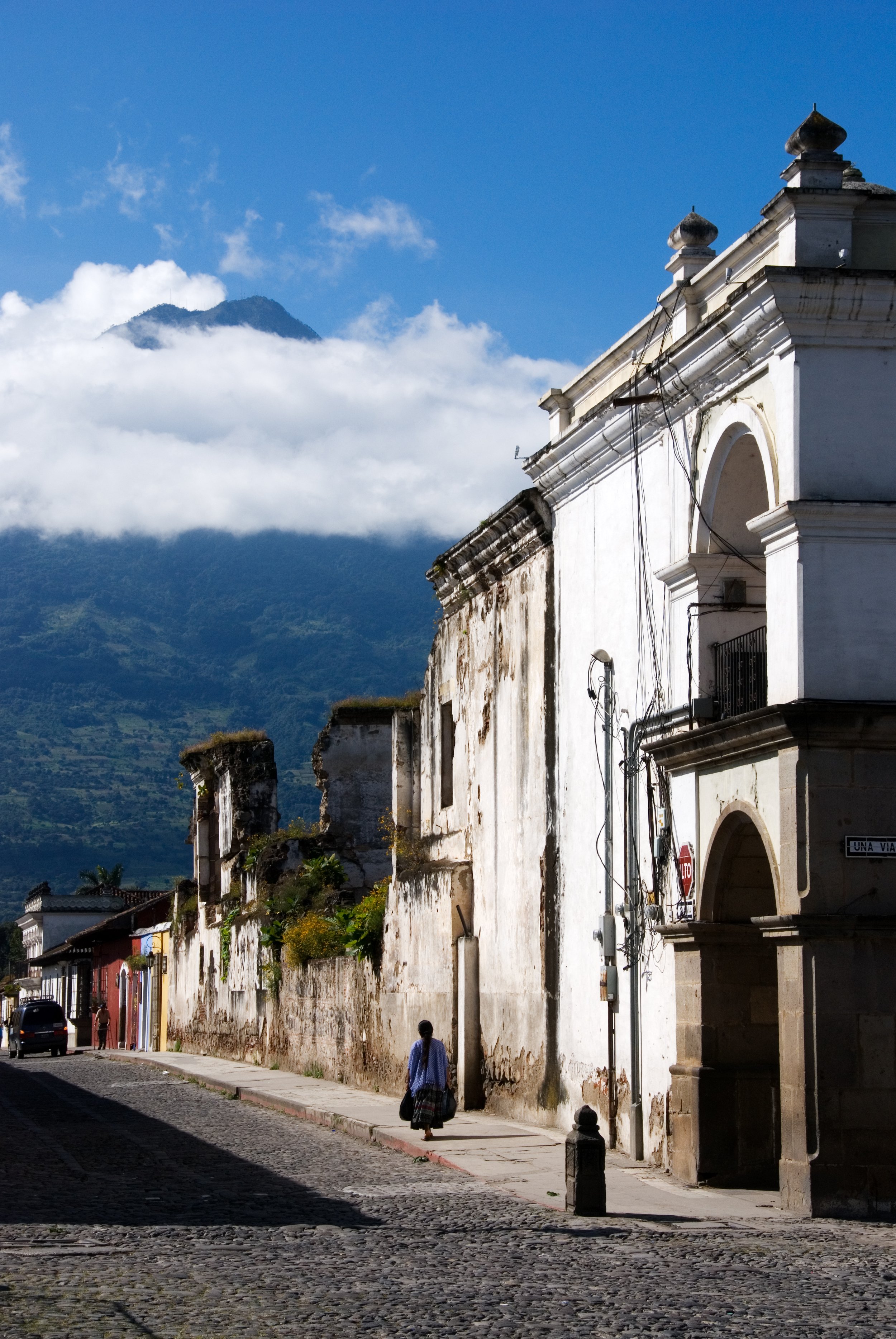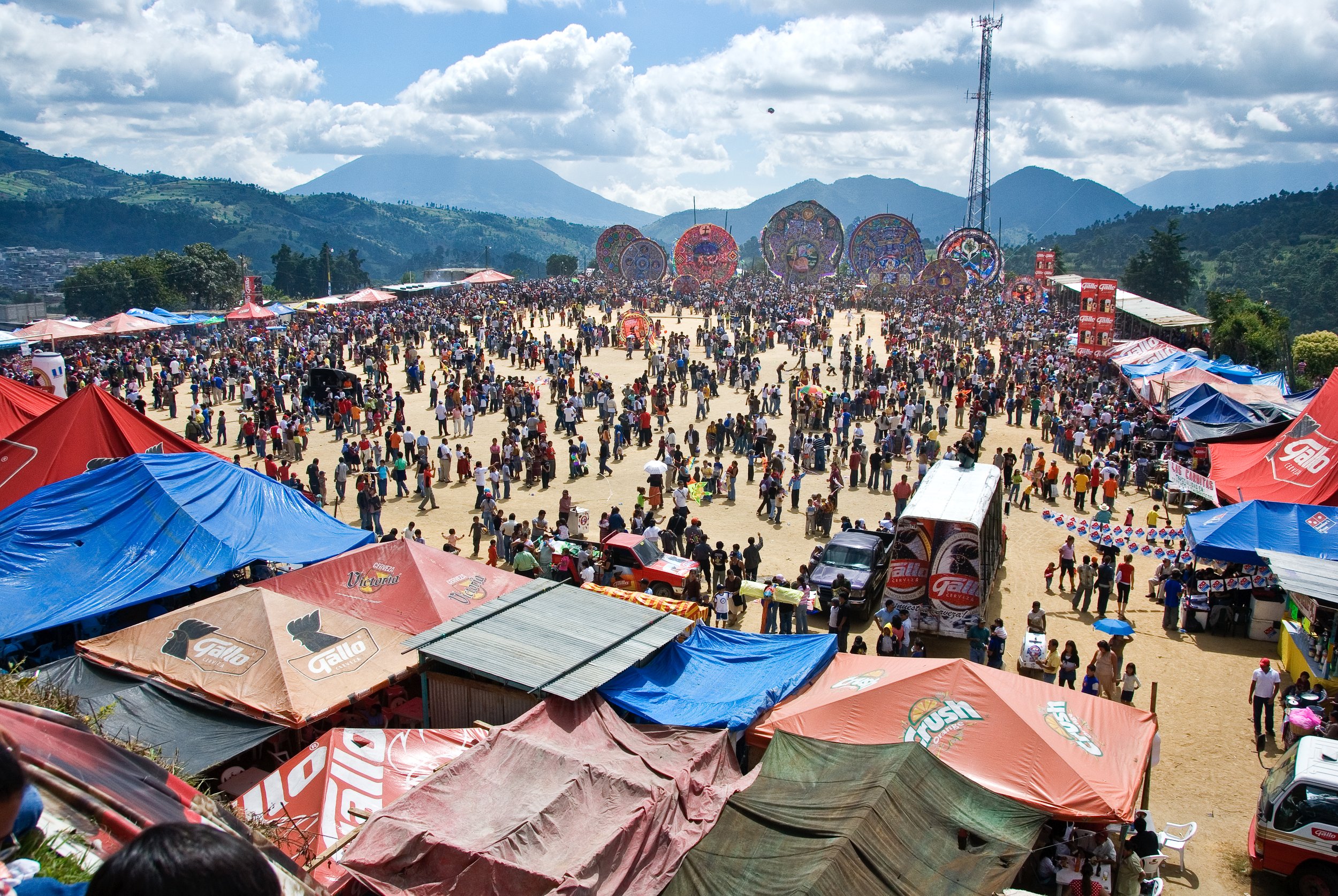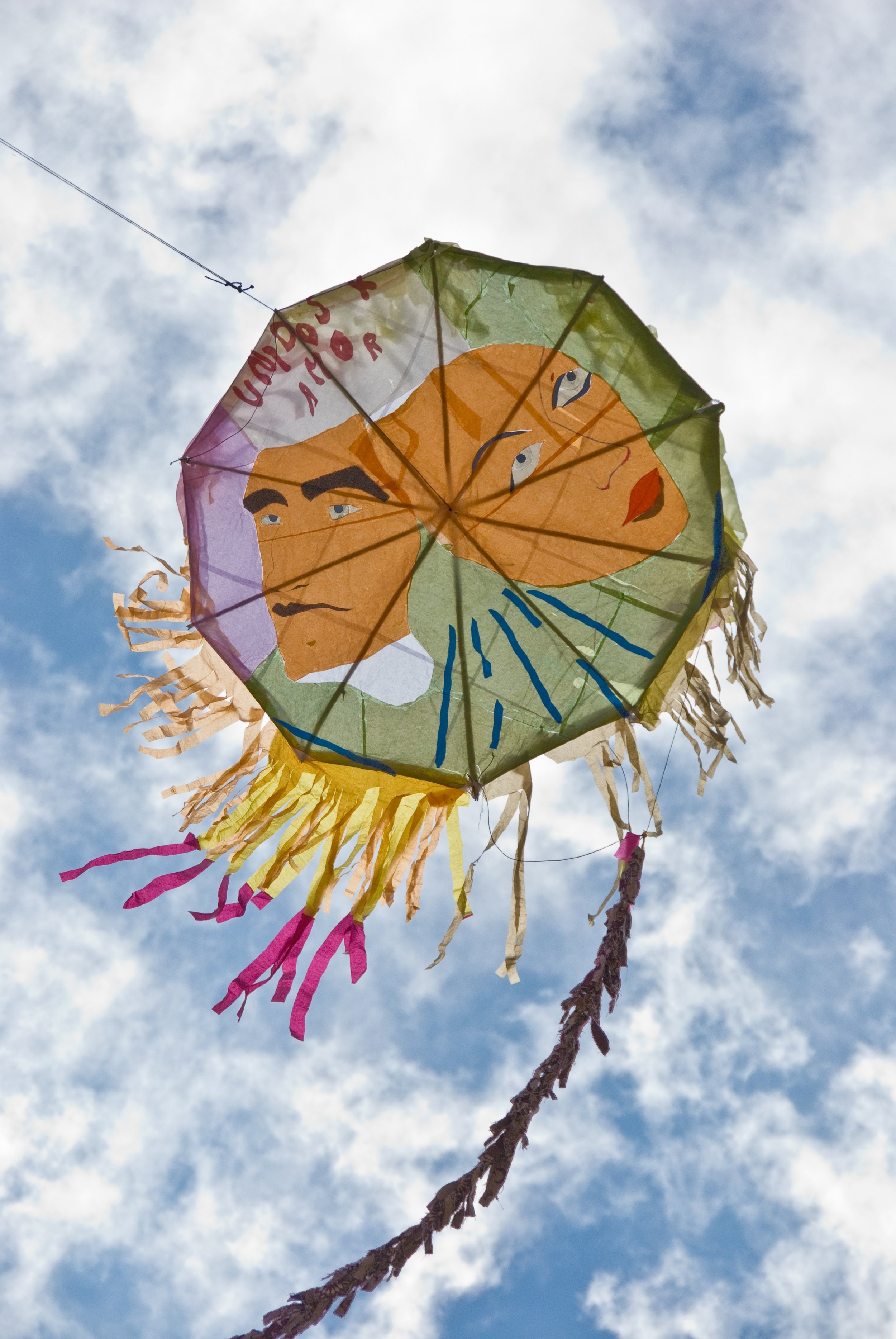Mexico has its sugar candy skulls and skeleton folk art. Guatemala has kites.
Too big to fly, but amazing to see, Guatemala’s kites rise in Sumpango on the Day of the Dead.
The charming Pixar movie, Coco, got it right. All Saints’ Day is a moment to remember our lost loved ones, to keep their memories alive.
My most striking Day of the Dead came along on November 1st 2007, in Guatemala. Back when newspapers had travel sections, I had a recurring gig to write and photograph for syndicated travel stories that showed up in those long-gone colorful Sunday supplements. My smart and demanding editor at Universal Press Syndicate, Harriet Choice, sent me to some rewarding places, and one of the best was Guatemala.
The premise: my wife and I would enroll in an intensive Spanish language school for a week and then take our new skills out into the country and see how well we could do. The highlight of our travels came on the Day of the Dead, in Sumpango, where local folks not only visit the cemetery to commune with their deceased family members but also build kites to carry messages to guide spirits on their journeys from heaven to earth. Some of those kites are too big to fly—so big, in fact that they become monumental folk-art sculptures.
My Guatemala story is still archived in the nether reaches of the Internet on a few newspaper sites, but without photos and with a lot of ads. I’ll reprint the piece here; I’m pleased with how well it holds up.
Joanne and I returned to Guatemala a few months ago—our first trip outbound from the United States since the pandemic. We found the country remarkably Covid-safe, with a national mask mandate honored by everyone, outdoor dining, half-empty buses with open windows. We came home healthy.
Even so, like every place, Guatemala has changed in these fifteen years. Antigua seemed to have lost some of its charm, and a young Guatemalan woman who served us at a terrific hole-in-the-wall restaurant, ¿Porque No?, confirmed our observation. She told us that young people from Guatemala City had discovered Antigua, and that the town now had more bars than art galleries.
Mayan fashion had changed, as well. The colorful hand-woven traje of the Mayan women has gained an overlay of bling—wildly colorful embroidery and lacy applique. “Tradition” keeps changing. Who knows what comes next?
So—here is my story from Spring 2008, with photographs from both trips.
"¿Cuanto cuesta?" From Language School to Market Stall in Guatemala
"¿Tienes cambio?" asked my wife, Joanne. "Do you have change?" Rosa's face fell. Joanne and Rosa had agreed on 12 quetzales—less than $2.00—for a hand-woven Mayan scarf, but the twelve-year-old businesswoman couldn't make change. She offered to escort us down the block in this Guatemalan market town of Chichicastenango to find the small change we needed to take home her scarf.
We walked narrow streets in the cool highland sun, skirting taco stands and teetering piles of brilliant textiles and dodging fleets of red three-wheeled tuk-tuk taxis recently imported from Thailand and now thundering over colonial cobblestones. Chatting and joking with Rosa, Joanne was gleeful. We had traveled to Latin America several times, but she had always relied on my high school Spanish to get us through. She hated being dependent and cut off from the experience and the people. So she had studied Spanish back home in Salt Lake City for a year. And now we had spent a week in Spanish school in Antigua, Guatemala, before venturing out into the country for ten days—eager to test our newly polished skills.
Rosa's booth in the market square in "Chichi" was our first stop. I photographed as Joanne took the lead in speaking to vendors, bantering and bargaining. Spanish was the second language on both sides, since the weavers were Mayan people who spoke one of twenty-three indigenous languages alive and well in Guatemala, where millions of Maya remain culturally separate, totaling more than half the Guatemalan population—the largest concentration of indigenous people in the Americas.
The conquistadores made the mistake of building Antigua, the original capital of Spanish colonial Guatemala, too close to the trio of volcanoes that ring its valley. Earthquakes, landslides, and eruptions from Volcán Fuego rattled the town until the colonists gave up in 1773 and moved to Guatemala City. The old capital was now "La Antigua Guatemala," "Old Guatemala," and, finally, just "Antigua," a place of ruins.
Restoration began in the 1940s, accelerated by national preservation legislation in 1969. A 1976 earthquake and the thirty-six-year civil war devastated the national economy, but Antigua's earthquake-battered architecture is so rich that the small city—its colonial core just 12 blocks square—was designated a United Nations World Heritage Site in 1979. Gradually, Antigua came to life, its local economy built around Spanish language schools.
First came Francisco Marroquín, the oldest school, begun by rural development workers in 1969 (and still teaching classes in both Spanish and Mayan languages). Elizabeth Bell, resident historian of Antigua and longtime cultural guide to the city, says that "the Internet really brought Antigua to life," coinciding with the 1996 peace accords that ended the war. Today, she counts 65 language schools with 1000 students enrolled during any given week in the December-August busy season. Those schools provide 1000 teaching jobs—for the standard is one-on-one teaching—and a guaranteed clientele for hotels, restaurants, salsa dancing classes, Internet cafes, international phone centers, volcano tours, and spas.
Choosing a school is the most confusing task of a trip to Antigua. We chose San José el Viejo for its beautiful gardens, relatively small size, and reputation for high-quality teaching. Writing or e-mailing several schools will give you a feel for their responsiveness. If you can, come to town and spend a couple of days strolling the cobblestone grid, talking with several schools and searching for a good match. Sign up for no more than a week. Guatemalans are gracious, the school programs are flexible, and you are the customer. Schools pair you with an appropriate teacher: by gender, age, and ability. But if you don't click, ask to switch in the first couple of days. If you aren't happy with your school, try another.
We spent three-and-a-half hours each morning and two-and-a-half each afternoon with our teachers, talking, practicing, and studying. Those hours of conversation open wide a window into Guatemalan culture. Afternoon sessions with teachers often include speaking Spanish while visiting weaving shops, museums, or artisan cooperatives. Joanne's teacher, Mercedes de Montiel, even invited us to attend her son's high school graduation ceremony, giving us a glimpse into the everyday life of Antiguans.
I can still reach far back in my memory and reel up virtual copies of vocabulary lists from Mr. Heath's Spanish class at Jefferson High School in Denver, but my teacher in Antigua, Gladys Rivera, pushed me hard to use those words in sentences that included more than just present tense. When I would wear down in my efforts to respond to Gladys, she would shift to tales about her family history or Guatemalan folklore that, miraculously, I could understand. She had an acute sense of just what level to pitch her vocabulary, an intuition honed by 35 years of teaching.
Though we stayed with a Guatemalan family, after so much Spanish-speaking we needed a break, and at meals we spoke mostly English with the two other students rooming in our home as we gobbled our rice, beans, fried plantains, chicken stews, and chuchitos—small tamales. Guatemalans favor delicate flavors and affectionately make fun of Mexicans for ruining food with too much spice.
One fellow student from Tucson offers this advice: expect to be pushed to your zone of discomfort, for that is where your teacher will take you. That zone is where you learn. You can start from scratch or from near-fluency; since teaching is individualized, there is no pressure to compete with other students. My teacher, Gladys, recommends four weeks of school if you have the time and interest, freeing you to explore the country on four weekend trips (Chichicastenango, Lake Atitlán, the magnificent Mayan ruins and rainforests at Tikal, the Caribbean coast at Livingstone, or ecotourism activities in the cloudforest wilderness around Cobán).
Would Joanne and I come back? Absolutely. But for a vacation, we would attend school only in the mornings, and spend the afternoons on our own, relaxing and exploring Antigua. It's a rich, walkable environment, an ideal home base for exploring the country.
In the United States we tend to think of Guatemala as distant and exotic. We forget it's the first country south of Mexico, from Atlanta just a few minutes more distant by air than Denver. The country earned its reputation for violence through a horrific civil war and ongoing narcotics trafficking, but major destinations are safe, and tourist police escort you for free to sites that are still questionable. Guatemala City remains daunting, and most visitors shuttle from the capital city's gleaming new airport to easygoing Antigua, less than an hour away.
In high season, Antigua comes alive with travelers, young and old, resembling a university district in a much larger town. Women traveling alone feel safe and comfortable here. We visited during the off-season, just as the summer rainy season ended at the beginning of November. For all its near-European comfort and sophistication, the city has an edge, for looming over the city are those 13,000-foot volcanoes. Volcán Fuego ("fire" in Spanish) is active, and we saw belches of ash more than once. The Antiguans hardly look up.
Volcanoes also ring the azure crater lake of Atitlán, where motor launches power you from village to village—to the New Age mecca of San Marcos, with its yoga and massage center; the bohemian traveler's haven of San Pedro; and the bustling indigena city of Santiago Atitlán. We favored the latter, a charming lakeshore town nestled between three graceful volcanic cones.
But first we went to Chichicastenango—on Saturday afternoon so we could watch the town come to life Sunday morning at the start of the grandest weekly market in the country, a swirl of color powered mostly by the women (and some men) in their traditional costumes (traje). Indigenous people come from far across the Guatemalan highlands each week to sell to each other and to tourists. The larger crowds arriving by shuttle bus from Antigua (three hours) or Lake Atitlán (one hour) for a midday visit miss the early morning hours that begin with barking dogs cueing the roosters. Strings of firecrackers follow, crackling like rain on metal roofs, and cherry bombs provide the final awakening jolt, mimicking a propane tank explosion next door. Guatemalans love fireworks, and visitors to the country quickly accept this fact. Finally, after dawn, the daylong boom of prayers begins, broadcast from ubiquitous evangelical churches.
The Chichicastenango plaza has become a permanent marketplace, with a grid of stalls and scaffolding covered with black plastic. The diversity in textiles is thrilling; each of 150 Mayan villages has developed unique patterns and color combinations woven by hand into blouse and skirt. The weavers may carry cell phones and call out in English to visiting gringos, but Chichi is a bastion of traditionalism. Plenty of Sunday commerce still takes place on the surrounding streets and fringes of the plaza, where food and furniture and animals change hands.
The flower sellers perch on the sacred steps of the old Santo Tomás church among Mayan priests burning incense and offerings.
After our visits to Chichicastenango and Atitlán, we returned to Antigua, as so many travelers do, enjoying the familiarity and fine restaurants and resting up for another adventure. We had timed our visit to Guatemala to be here for the Day of the Dead celebration on All Saint's Day, November 1st.
Mexico has its sugar candy skulls and skeleton folk art. Guatemala has kites.
All Saint's Day brings tens of thousands of mostly Guatemalan visitors to Santiago and Sumpango, in the small department of Sacatepéquez just off the Interamerican Highway between Antigua and Guatemala City. We bussed to Sumpango with pairs of students and teachers from Antigua's La Unión Spanish school. Teams of young people in Sumpango had spent the previous forty days designing and building kites, tying on tails made from woven cloth that carry messages to guide spirits on their journeys from heaven to earth. Both boys and girls participate in design; young men fly the larger kites. When the young unmarried men travel to the coast to gather bamboo for the frames, they pass from boys to men in the course of this coming-of-age pilgrimage.
On the morning of November 1st, families gathered in the cemetery, cleaning and remudding and whitewashing grave mounds amongst the smoky fragrance of pine-resin copal incense. They decorated graves with plastic streamers, marigolds, and pine needles and then spent the day cooking and eating while surrounded by their lost loved ones, telling stories, catching up with neighbors, renewing connections through the generations.
We passed through these moving scenes in the cemetery and walked uphill through a full-blown street fair, past booths selling kites and grilled corn (served with lime and coarse salt) and the usual stunning array of textiles, in a crush of visitors. The path led through giant inflated beer cans emblazoned with Gallo-brand rooster logos to the soccer pitch. At the far end of the field stood the largest kites, fifty feet high, tethered to tree trunks—and too big to fly.
In each row out into the field, lined up for judging, the ranks of kites stepped down in size, each displaying a story constructed from brightly colored tissue paper—scenes of Mayan culture, family values, rainforest ecology, and memorials to victims of La Violencia (the decades of civil war and genocide). As the afternoon progressed, the play-by-play announcer asked the keepers of each fleet of kites to take a turn at flying, starting with the smallest kites made by the youngest kids. By mid-afternoon, kites twenty feet in diameter darted over a sun-spattered mosaic of crowds and Mayan costume, the great rounds of the largest kites standing behind like a theatrical backdrop, and on the horizon, the cones of the Guatemalan volcanic mountains.
With our new and improved Spanish, I realized that our experience in Sumpango was more than just touristic. We weren't just watching. With the simple fact of sharing a language, we became participants. We could ask for directions. We exchanged greetings and jokes on the paths. We weren't just gringos and Mayans and mixed-blood Ladinos, we were fellow travelers—together—kite flyer and visitor, reveling in beauty and tradition and family on these green ridgelines in the volcanic highlands of Guatemala.









